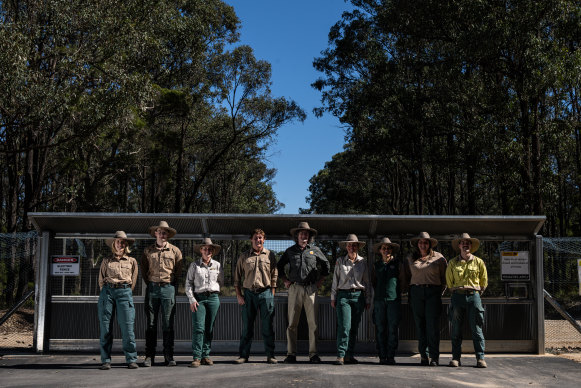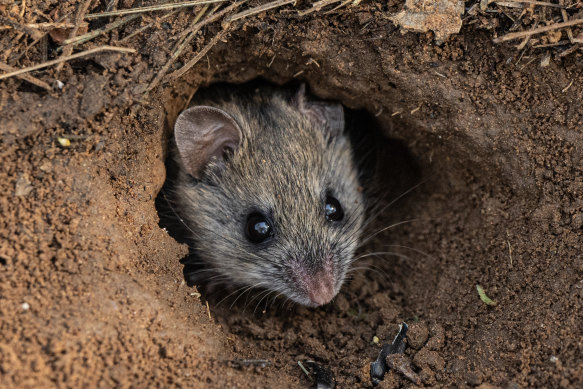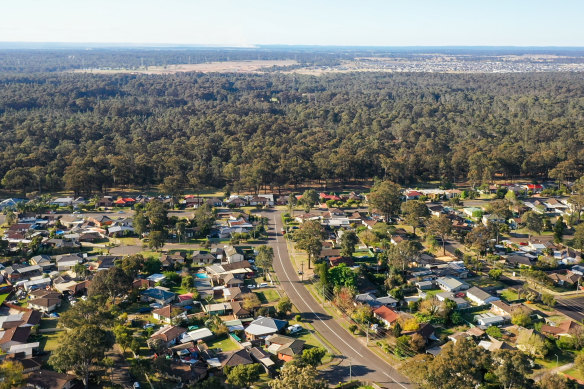The ‘time capsule’ being built in the middle of suburban Sydney
At a new national park nestled in suburban Sydney, locally extinct animals are coming back one species at a time.
The project involves reintroducing up to 30 native animals, mostly species that are either extinct in NSW or in the local area, to a 550-hectare reserve in the heart of western Sydney, in what the head of the national parks service calls “the ultimate in ecosystem restoration”.

NSW National Parks and Wildlife Service staff at the gates to Yiraaldiya National Park in Shanes Park.Credit: Nick Moir
So far, ecologists have released three species behind a predator-proof fence to keep out foxes and cats: koalas, eastern bettongs and New Holland mice. Future releases could include 30 native mammals, birds, reptiles and frogs, including quolls, emus, and diamond pythons.
NSW National Parks and Wildlife Service (NPWS) deputy secretary Atticus Fleming describes the work at Yiraaldiya National Park, which was only declared a national park last year and is still not open to the public, as like building a time capsule.
“Once people can visit, coming through that front gate will be a bit like stepping back in time,” Fleming said.

A New Holland mouse pokes its head out of its burrow at Yiraaldiya National Park in western Sydney.Credit: Nick Moir
“They’ll be able to see the bush here as it was a couple of hundred years ago, alive with these little native mammals, many of which have been gone for not just decades, but in some cases a hundred years.”
Fleming said that early European explorers described hillsides teeming with rock wallabies and having to dismount from their horses because of all the holes and burrows in the ground. Conservationist Tim Flannery has called our modern-day national parks “marsupial ghost towns”, and Fleming said native rodents had declined even more than marsupials.
Fleming hopes to attract visitors to Yiraaldiya for evening tours to spot nocturnal animals, and bird watchers for the speckled warbler. There would be opportunities for members of the local Aboriginal community to run tours.
First, NPWS has to complete the perimeter fence, which will span 10.2 kilometres. The animals are currently in a 56-hectare fenced area near the entrance to the park.
The New Holland mouse is the latest species reintroduced to the bushland after 18 of them, bred in captivity at the Australian National University, were recently released. The native rodent was presumed extinct in NSW until it was rediscovered in Ku-ring-gai Chase National Park in 1967.
The mice join three koalas and four eastern bettongs – a creature that, like a bandicoot, works as an “ecosystem engineer” in digging up the soil and spreading native fungus.
NPWS plans to increase the numbers, monitor genetic diversity, and work to release other animals including native predators.
The Albanese government on Wednesday announced it would add 20 species and one ecological community as either endangered or critically endangered under national environment law – 15 plants, two lizards, one sea snake, one crayfish, one fish and the King Island scrub complex.

Yiraaldiya National Park is a 550-hectare reserve next to Sydney suburbs and land slated for new development.
Saturday is Threatened Species Day and the World Wide Fund for Nature has scored Australia an F for funding, recovery planning and improving the threat status of more than 2000 at-risk species in Australia. The environmental charity considered the 163 species added to the threatened species list since the first scorecard was released two years ago.
Fleming said Australia was responsible for about a third of all mammal extinctions globally in the past 400 years. The United States had only had one mammal extinction in that time, compared with 34-40 in Australia.
“Australia is the global epicentre of extinctions, basically,” Fleming said. “The driver for those mammal extinctions, the primary driver, is cats and foxes.”
Australian government figures suggest 5.6 million feral cats kill more than 1.5 billion native mammals, birds, reptiles and frogs, and 1.1 billion invertebrates each year.
Federal Environment Minister Tanya Plibersek last week committed $60 million to feral cat control projects, including exploring the use of traps enabled by artificial intelligence.
Fleming said foxes could be baited, but cats typically could not.
NPWS is currently recruiting for five hunters to shoot feral cats, based in Dubbo, Broken Hill or Bourke, paying from $79,000 to $102,000 depending on seniority.
Fleming said there were also trials of other approaches including better traps and training native animals to be afraid of cats, and research about genetic solutions such as manipulating feral cats to only give birth to male babies.
But Fleming said these were all long-term projects and without feral-free areas like Yiraaldiya there would be “nothing left to save”.
Research published in Conservation Biology in 2022 found that populations of species in feral-free areas, including both fenced areas and islands, had increased by 680 per cent from 2000-2017. Unmanaged populations outside these havens declined by 63 per cent over the same timeframe, while populations outside havens with intensive control of predators still declined 53 per cent.
NSW now has seven fenced feral-free areas, including 4000 hectares at Sturt National Park, 5800 hectares at Pilliga State Conservation Area, and 9570 hectares at Mallee Cliffs National Park.